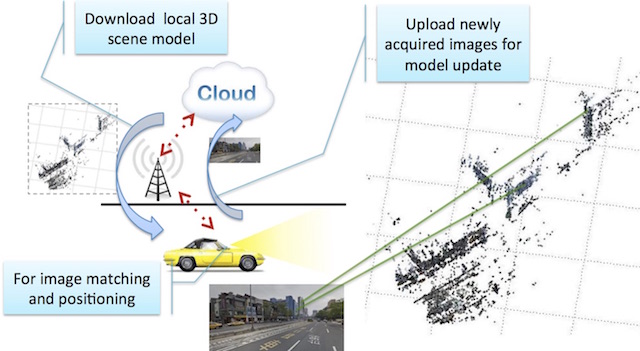Vision-Based Positioning for Internet-of-Vehicles
Vision-Based Positioning for Internet-of-Vehicles
Introduction
Ego-positioning aims at locating an object in a global coordinate system based on its sensor inputs. With the growth of mobile or wearable devices, accurate positioning has be- come increasingly important. Unlike indoor positioning, considerably less efforts have been put into developing high-accuracy ego-positioning systems for outdoor environments. Global Positioning System (GPS) is the most widely used technology implemented in vehicles. However, the precision of GPS sensors is approximately 3 to 20 meters, which is not sufficient for distinguishing the traffic lanes and highway lane levels critical for intelligent vehicles. In addition, the existing GPS systems do not work properly in urban areas where signals are obstructed by high rise buildings. Although several positioning methods based on expensive sensors, such as radar sensors and Velodyne 3D laser scanners, can achieve high accuracy, they are not widely adopted because of cost issues. Hence, it is important to develop accurate ready-to-deploy IoV approaches for outdoor environments.
We presents an algorithm for ego-positioning by using a low-cost monocular camera for systems based on the Internet-of-Vehicles (IoV). To reduce the computational and memory requirements, as well as the communication load, we tackle the model compression task as a weighted k-cover problem for better preserving the critical structures. For real-world vision-based positioning applications, we consider the issue of large scene changes and introduce a model update algorithm to address this problem. A large positioning dataset containing data collected for more than a month, 106 sessions, and 14,275 images is constructed. Extensive experimental results show that sub- meter accuracy can be achieved by the proposed ego-positioning algorithm, which outperforms existing vision-based approaches.
Overview of the algorithm
(a) training phase: images from passing vehicles are uploaded to a cloud server for model construction and compression;

(b) ego-positioning phase: SIFT features from images acquired on vehicles are matched against 3D models previously constructed for ego-positioning. In addition, the newly acquired images are used to update 3D models.

Result
Video on Youtube:http://www.youtube.com/embed/ZLjHGcqhbYA
Dataset
http://www.clarenceliang.com/dataset
Related Publications
[1] Kuan-Wen Chen, Chun-Hsin Wang, Xiao Wei, Qiao Liang, Ming-Hsuan Yang, Chu-Song Chen, and Yi-Ping Hung, “Vision-Based Positioning for Internet-of-Vehicles,” IEEE Transactions on Intelligent Transportation Systems, 2017.
[2] Kuan-Wen Chen, Chun-Hsin Wang, Xiao Wei, Qiao Liang, Ming-Hsuan Yang, Chu-Song Chen, and Yi-Ping Hung, “Vision-Based Positioning with Sub-meter Accuracy for Internet-of-Vehicles,” the 28th IPPR Conference on Computer Vision, Graphics, and Image Processing, Aug., 2015. (Best Paper Award)
Vision-Based Positioning for Internet-of-Vehicles的更多相关文章
- VIPS: a VIsion based Page Segmentation Algorithm
VIPS: a VIsion based Page Segmentation Algorithm VIPS: a VIsion based Page Segmentation Algorithm In ...
- Computer English Notes
Chapter 1 : About Computer Answer the following - Abbreviation LBS - Location-Based Services HTML - ...
- REST is not the Best for Micro-Services GRPC and Docker makes a compelling case
原文:https://hackernoon.com/rest-in-peace-grpc-for-micro-service-and-grpc-for-the-web-a-how-to-908cc05 ...
- 【AR实验室】ARToolKit之概述篇
0x00 - 前言 我从去年就开始对AR(Augmented Reality)技术比较关注,但是去年AR行业一直处于偶尔发声的状态,丝毫没有其"异姓同名"的兄弟VR(Virtual ...
- Socket网络编程一
1.Socket参数介绍 A network socket is an endpoint of a connection across a computer network. Today, most ...
- Python之路,Day8 - Python基础 面向对象高级进阶与socket基础
类的成员 类的成员可以分为三大类:字段.方法和属性 注:所有成员中,只有普通字段的内容保存对象中,即:根据此类创建了多少对象,在内存中就有多少个普通字段.而其他的成员,则都是保存在类中,即:无论对象的 ...
- Python之路第一课Day8--随堂笔记(socket 承接上节---网络编程)
本节内容 Socket介绍 Socket参数介绍 基本Socket实例 Socket实现多连接处理 通过Socket实现简单SSH 通过Socket实现文件传送 作业:开发一个支持多用户在线的FTP程 ...
- python走起之第八话
1. Socket介绍 概念 A network socket is an endpoint of a connection across a computer network. Today, mos ...
- Python学习路程day8
Socket语法及相关 socket概念 A network socket is an endpoint of a connection across a computer network. Toda ...
- 大规模视觉识别挑战赛ILSVRC2015各团队结果和方法 Large Scale Visual Recognition Challenge 2015
Large Scale Visual Recognition Challenge 2015 (ILSVRC2015) Legend: Yellow background = winner in thi ...
随机推荐
- 60分钟内从零起步驾驭Hive实战学习笔记(Ubuntu里安装mysql)
本博文的主要内容是: 1. Hive本质解析 2. Hive安装实战 3. 使用Hive操作搜索引擎数据实战 SparkSQL前身是Shark,Shark强烈依赖于Hive.Spark原来没有做SQL ...
- 8086键盘输入实验——《x86汇编语言:从实模式到保护模式》读书笔记07
1.BIOS中断 我们可以为所有中断类型自定义中断处理过程,包括内部中断.硬件中断和软中断. BIOS中断,又称BIOS功能调用,主要是为了方便地使用最基本的硬件访问功能.通常,为了区分针对同一硬件的 ...
- File类--随笔
package io; import java.io.File; import java.io.FileNotFoundException; import java.io.FileReader; im ...
- intent 活动之间穿梭
1.从当前activity,跳转到当前应用程序的activity Intent intent = new Intent(MainActivity.this, Intent2Activity.class ...
- C# string Stream 互转
使用C#将字符串转化成流,将流转换成字符串,代码如下: using System.IO; using System.Text; namespace CSharpConvertString2Stream ...
- 【HTML&CSS】文本的基本处理
其实在写这篇博客的时候已经学了很久,也写了不少代码,特别是很枯燥的看完整个html部分,因为不带有CSS写出来的东西干巴巴的一点也不好看. 直到展开CSS学习才开来补上博客,嗯,这是个好习惯. 这是运 ...
- webstorm上传vue代码至git
Git在push时候,提示:push to origin/master was rejected 解决方案如下: 提交代码顺序 webstorm右键项目名称==>Git==>Commit ...
- iOS开发之Objective-c的AES128加密和解密算法的实现
#import <Foundation/Foundation.h> #import <CommonCrypto/CommonDigest.h> #import <Comm ...
- 工作流一期上线原创小故事——【加签】OR【不准】
亲!您有过选择[加签]还是审核[不准]的烦恼吗? 加签分为:向前加签和向后加签,这个相信大家都很熟悉了吧. 审核分为:准和不准,就是√和×,这个相信大家也很熟悉了. 提示①:相邻的2个人审核时,如果意 ...
- 22_AOP_切面——静态切面
[Spring AOP 如何定位连接点] 1.增强提供了连接点的方位信息:如织入到方法前面.后面等. 2.切点描述的是织入到哪些类的哪些方法上. [切点] Spring通过org.springfram ...
